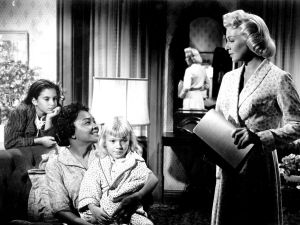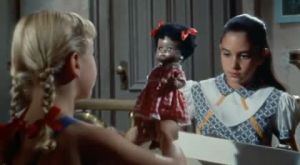Difference between revisions of "Imitation of Life (1959)"
| Line 19: | Line 19: | ||
==Reference== | ==Reference== | ||
| − | [[Category:Black Racism in Drama Movies]] | + | [[Category:Black-Targeted Racism in Drama Movies]] |
<references /> | <references /> | ||
Latest revision as of 06:39, 15 March 2021
Imitation of Life is American Drama movie who released on April 30, 1959 (US). Directed by Douglas Sirk and produced by Ross Hunter, this 125-minute film tells the story of an aspiring white actress bringing an African-American widow into In the despair of the biracial daughter, she was regarded as white. Imitating Life is based on Fannie Hurst's 1933 novel of the same name. It starring
- Lana Turner as Lora Meredith
- Juanita Moore Annie Johnson
- John Gavin as Steve Archer
- Sandra Dee as Susie (16)
- Susan Kohner as Sarah Jane (18)
Plot
The story begins in 1948, when the widowed mothers of two widows met on Coney Island: an aspiring actress, Lana Turner, was white, and an unemployed homeless woman, Annie Johnson (Juanita Moore) is black. . The Johnsons live with Meredith. Annie keeps the house while Lora auditions. Ten years later, Lora became a Broadway toast, and Annie (still calling her Miss Laura) continued to maintain the house. At the same time, the relationship between Lora and the playwright (Dan O’Herlihy), the advertiser (John Gavin) and her daughter (Sandra Dee) is in trouble. Annie’s fair-skinned underage daughter, Sarah Jane (Susan Kohner), plays the impetuous showgirl, passing by like white people. Although the white people passed like a happy one, Anne exhausted her anger and maintained self-control. [1]
Controversy
There is a scene where two girls play with dolls. There is a white doll and a black doll. Susie naturally gifted the black doll to Sarah Jane, but Sarah Jane threw it on the ground and asked for the white doll. Because she didn't want to be considered black. There is also a scene where Sara Jane feels inferior or beaten by her boyfriend at school because he discovered that Sara is black and no one criticizes racists. On the contrary, they are arguing about how terrible Sara Jane is telling people about her. White people who are white people. "In the 1934 film, no one speaks out against racism".
Sarah does not want to be considered black, but she wants the opportunity to pretend to be a white woman. The problem is that whenever Annie shows up and announces that she is Sarah-Jane's mother, her cover is blown up and she feels ashamed of her true identity. [2]his also shows that if a black person wants to get a job, she/he cannot succeed in white job "The problem, we’re told, isn’t that whites are racist against blacks, but that blacks really can’t be like whites. Instead, they should embrace their blackness and be like the well-cared-for". [3]


